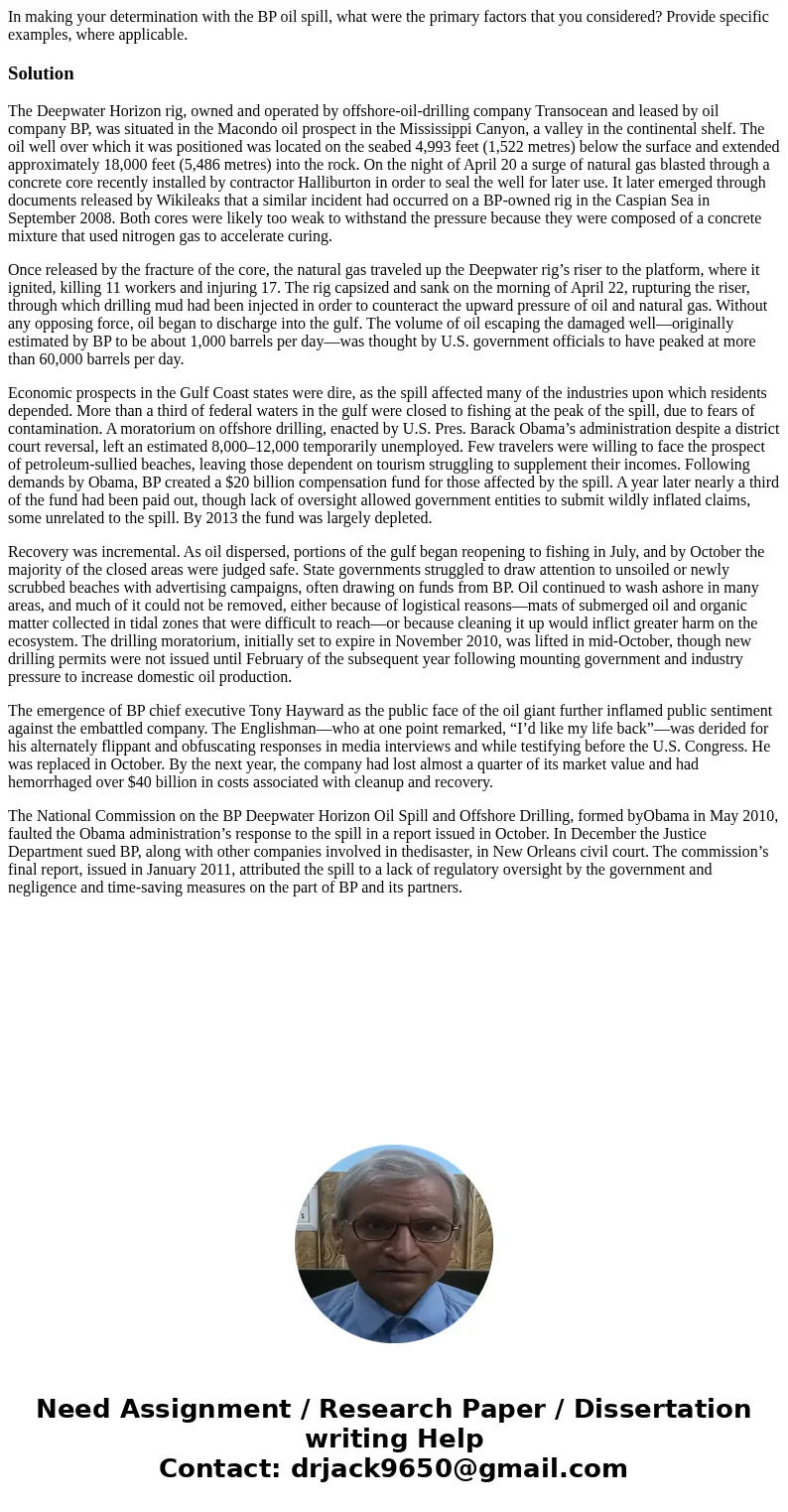In making your determination with the BP oil spill what were
In making your determination with the BP oil spill, what were the primary factors that you considered? Provide specific examples, where applicable.
Solution
The Deepwater Horizon rig, owned and operated by offshore-oil-drilling company Transocean and leased by oil company BP, was situated in the Macondo oil prospect in the Mississippi Canyon, a valley in the continental shelf. The oil well over which it was positioned was located on the seabed 4,993 feet (1,522 metres) below the surface and extended approximately 18,000 feet (5,486 metres) into the rock. On the night of April 20 a surge of natural gas blasted through a concrete core recently installed by contractor Halliburton in order to seal the well for later use. It later emerged through documents released by Wikileaks that a similar incident had occurred on a BP-owned rig in the Caspian Sea in September 2008. Both cores were likely too weak to withstand the pressure because they were composed of a concrete mixture that used nitrogen gas to accelerate curing.
Once released by the fracture of the core, the natural gas traveled up the Deepwater rig’s riser to the platform, where it ignited, killing 11 workers and injuring 17. The rig capsized and sank on the morning of April 22, rupturing the riser, through which drilling mud had been injected in order to counteract the upward pressure of oil and natural gas. Without any opposing force, oil began to discharge into the gulf. The volume of oil escaping the damaged well—originally estimated by BP to be about 1,000 barrels per day—was thought by U.S. government officials to have peaked at more than 60,000 barrels per day.
Economic prospects in the Gulf Coast states were dire, as the spill affected many of the industries upon which residents depended. More than a third of federal waters in the gulf were closed to fishing at the peak of the spill, due to fears of contamination. A moratorium on offshore drilling, enacted by U.S. Pres. Barack Obama’s administration despite a district court reversal, left an estimated 8,000–12,000 temporarily unemployed. Few travelers were willing to face the prospect of petroleum-sullied beaches, leaving those dependent on tourism struggling to supplement their incomes. Following demands by Obama, BP created a $20 billion compensation fund for those affected by the spill. A year later nearly a third of the fund had been paid out, though lack of oversight allowed government entities to submit wildly inflated claims, some unrelated to the spill. By 2013 the fund was largely depleted.
Recovery was incremental. As oil dispersed, portions of the gulf began reopening to fishing in July, and by October the majority of the closed areas were judged safe. State governments struggled to draw attention to unsoiled or newly scrubbed beaches with advertising campaigns, often drawing on funds from BP. Oil continued to wash ashore in many areas, and much of it could not be removed, either because of logistical reasons—mats of submerged oil and organic matter collected in tidal zones that were difficult to reach—or because cleaning it up would inflict greater harm on the ecosystem. The drilling moratorium, initially set to expire in November 2010, was lifted in mid-October, though new drilling permits were not issued until February of the subsequent year following mounting government and industry pressure to increase domestic oil production.
The emergence of BP chief executive Tony Hayward as the public face of the oil giant further inflamed public sentiment against the embattled company. The Englishman—who at one point remarked, “I’d like my life back”—was derided for his alternately flippant and obfuscating responses in media interviews and while testifying before the U.S. Congress. He was replaced in October. By the next year, the company had lost almost a quarter of its market value and had hemorrhaged over $40 billion in costs associated with cleanup and recovery.
The National Commission on the BP Deepwater Horizon Oil Spill and Offshore Drilling, formed byObama in May 2010, faulted the Obama administration’s response to the spill in a report issued in October. In December the Justice Department sued BP, along with other companies involved in thedisaster, in New Orleans civil court. The commission’s final report, issued in January 2011, attributed the spill to a lack of regulatory oversight by the government and negligence and time-saving measures on the part of BP and its partners.

 Homework Sourse
Homework Sourse